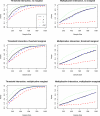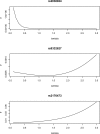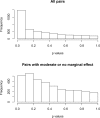Entropy based genetic association tests and gene-gene interaction tests
- PMID: 23089811
- PMCID: PMC3176139
- DOI: 10.2202/1544-6115.1719
Entropy based genetic association tests and gene-gene interaction tests
Abstract
In the past few years, several entropy-based tests have been proposed for testing either single SNP association or gene-gene interaction. These tests are mainly based on Shannon entropy and have higher statistical power when compared to standard χ2 tests. In this paper, we extend some of these tests using a more generalized entropy definition, Rényi entropy, where Shannon entropy is a special case of order 1. The order λ (>0) of Rényi entropy weights the events (genotype/haplotype) according to their probabilities (frequencies). Higher λ places more emphasis on higher probability events while smaller λ (close to 0) tends to assign weights more equally. Thus, by properly choosing the λ, one can potentially increase the power of the tests or the p-value level of significance. We conducted simulation as well as real data analyses to assess the impact of the order λ and the performance of these generalized tests. The results showed that for dominant model the order 2 test was more powerful and for multiplicative model the order 1 or 2 had similar power. The analyses indicate that the choice of λ depends on the underlying genetic model and Shannon entropy is not necessarily the most powerful entropy measure for constructing genetic association or interaction tests.
Figures






References
-
- Heit JA, Cunningham JM, Petterson TM, Armasu SM, Rider DN, de Andrade M. Genetic variation within the anticoagulant, procoagulant, fibrinolytic and innate immunity pathways as risk factors for venous thromboembolism. Journal of Thrombosis and Haemostasis. 2011;9, 6:1133–1142. doi: 10.1111/j.1538-7836.2011.04272.x. - DOI - PMC - PubMed
Publication types
MeSH terms
Grants and funding
LinkOut - more resources
Full Text Sources
Miscellaneous
